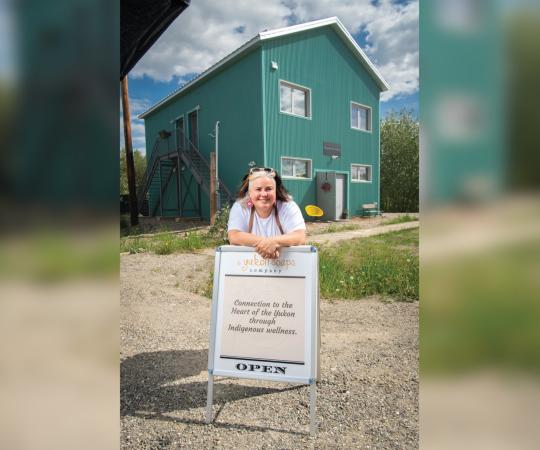THERE ARE 32 OPERATING and planned off-grid mines in Canada. That num- ber will need to get bigger if the economic development strategies of the Yukon, NWT, and Nunavut are to succeed. Especially if we are to step up and support the massive demand for minerals created by the planet’s climate transition. Consider: It takes two-and-a-half times the amount of copper to build an electric vehicle as it does to build a gas guzzler.
But how will those 32 mines be powered? According to a report by Pollution Probe (supported by Ontario Power Generation, a provincial Crown corporation) they’ll rely on diesel generators. A litre of diesel packs a big energy punch. It’s use- ful for both heat and electricity. It is produced at scale in southern Canada and is relatively cheap and easy to transport. That’s why we’ve spent the last century building diesel-based businesses and infrastructure North of 60°.
Unfortunately, diesel also spews carbon. And in our future Net Zero Canada, there will be no place for large carbon-spewing mines. The challenge is that a remote mine will need more than the five megawatts to 30 megawatts of power consumed today as the industry shifts to electric equipment. Northern miners, investors and policymakers have to find a replacement energy source. The ones that succeed will create new long-term businesses in the North.
There are a few options. One is to turn your off-grid mine into an on-grid one by joining another grid with surplus renewables. Connecting the Yukon power transmission system to British Columbia, for example, would give Yukon mines access to more hydro- power. Depending on assumptions, this would cost $1.5 billion to $2 billion. It would also mean all the jobs and investment opportunities from generating the power would end up in B.C.
Also, the idea only works in the Yukon. For Nunavut and large parts of the NWT, connecting to a provin- cial grid is prohibitively expensive.
Another option is wind and solar power paired with battery storage systems. But it’s dark in the winter and the wind doesn’t always blow. So, it takes a large—and costly— number of windmills and batteries to reliably heat a mine facility and power 400-tonne Komatsu electric mining trucks.
Renewable diesel, made from canola or similar crops, could work—and we could keep using our existing diesel infrastructure. How- ever, renewable diesel could be two to three times more expensive than fossil diesel. It is also not, at least so far, completely carbon-free. Plus, feeding canola to engines means you can’t feed it to people, a major issue as climate change starts hurting crop yields around the world.
Renewable liquefied natural gas (RLNG) is also an option. This is cap- tured from methane released from farms and landfills and could be fed into exist- ing LNG power plants. However, like re- newable diesel, it is expensive. And our farms and landfills generate a relatively small amount of it compared to all the sec- tors that currently use natural gas. Fertil- izer and chemical plants—as well as every building in Canada currently heated by gas—will be competing for scarce RLNG. Hydrogen could be an option, but it is expensive to transport long distances and to store. We would need new road and port infrastructure, possibly including ice-hardened tankers. Geothermal is also a possibil- ity. Technological advances, such as those pursued by Calgar y-based Eavor Technologies Inc., have great potential but likely only in parts of the North. Which gets us to a new form of nuclear power: Small Modular Reactors (SMRs). Could they work in the territories? Possibly. Eielson Air Force Base in Fairbanks, Alaska, plans to have a small five-megawatt reactor operating by 2027. Ontario Power Generation and others are pushing various designs through the Canadian regulator y process, with support from the federal government and a coalition of four provinces.
Designs vary for SMRs, but you can think of them generally as small power facilities with a self-contained module of nuclear fuel that can be easily shipped to a northern mine and returned to the factory for disposal when spent.
A 2021 study by Laurentian University’s Mining Innovation, Rehabilitation, and Applied Research Corporation, supported by industry players, estimated that SMR electricity at a northern mine would cost 39 cents per kilowatt-hour. That’s 12 cents more than fossil diesel, but not prohibitively more expensive. And if a few diesel engines were kept for times of peak demand, which allows a smaller SMR to be built while still achieving an 85 per cent reduction in car- bon emissions, the cost falls significantly.
Critically, these units also generate large amounts of heat for buildings and industrial processes.
Of course, getting a nuke approved in one of the territories will not be easy. It will be impossible without the buy-in of the local Indigenous community.
Interestingly, the experts are looking at different business models for SMRs. They might be owned by a mine, like diesel generators are today. Or the SMR might be owned by local investors to sell power and heat to the mine on a long-term contract.
Which raises an interesting idea for Indigenous development corporations: build and own the SMR powering a new mine. This dramatically expands the share of economic activity captured locally.
Leading Indigenous businesses have made great strides in building business partnerships with northern mines. But in the future, without low-carbon power, there may not be many northern mines at all. Owning an SMR may be a profitable new opportunity for Indigenous enterprises. It may also be something they have to do to sustain their existing business with the mining sector.










